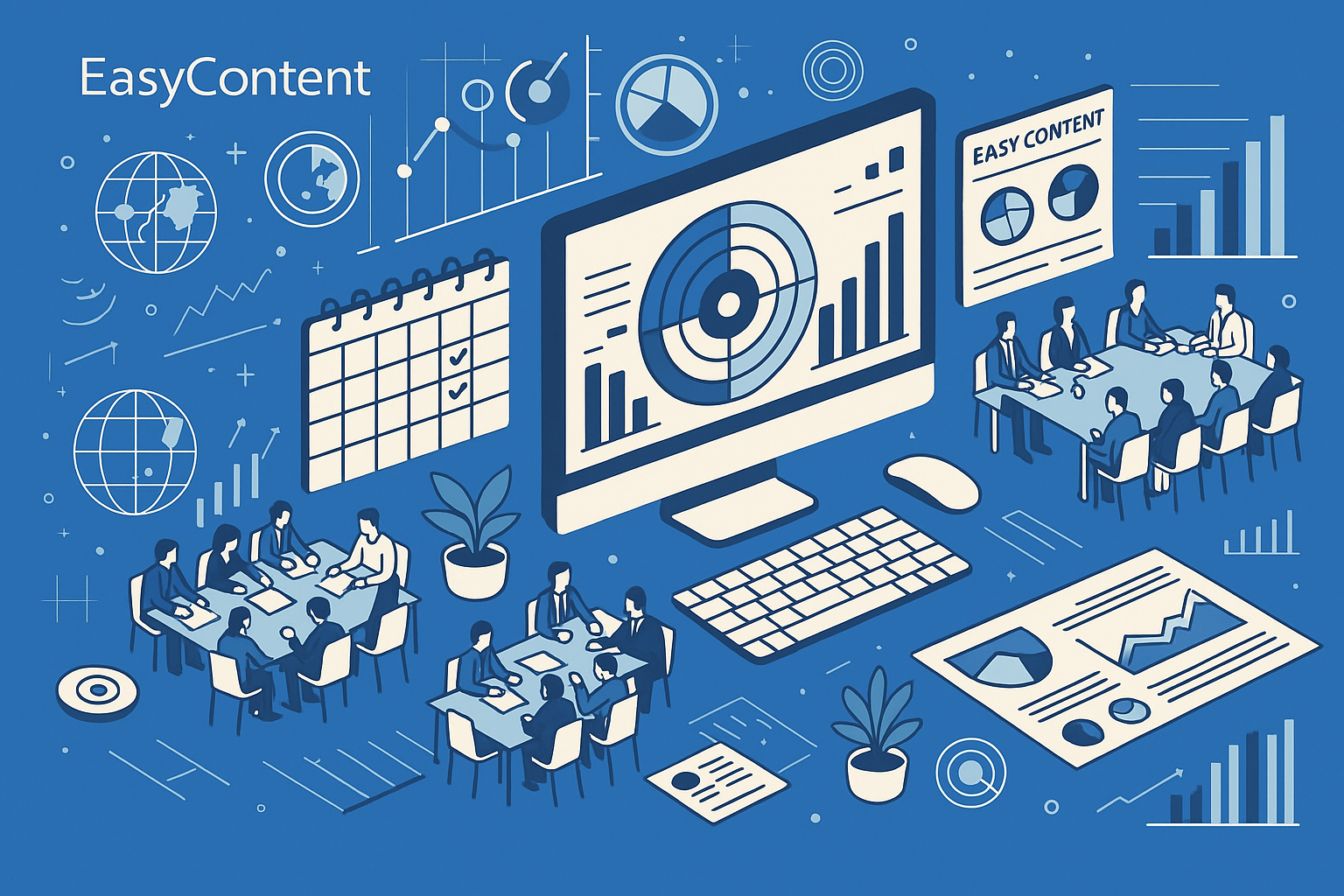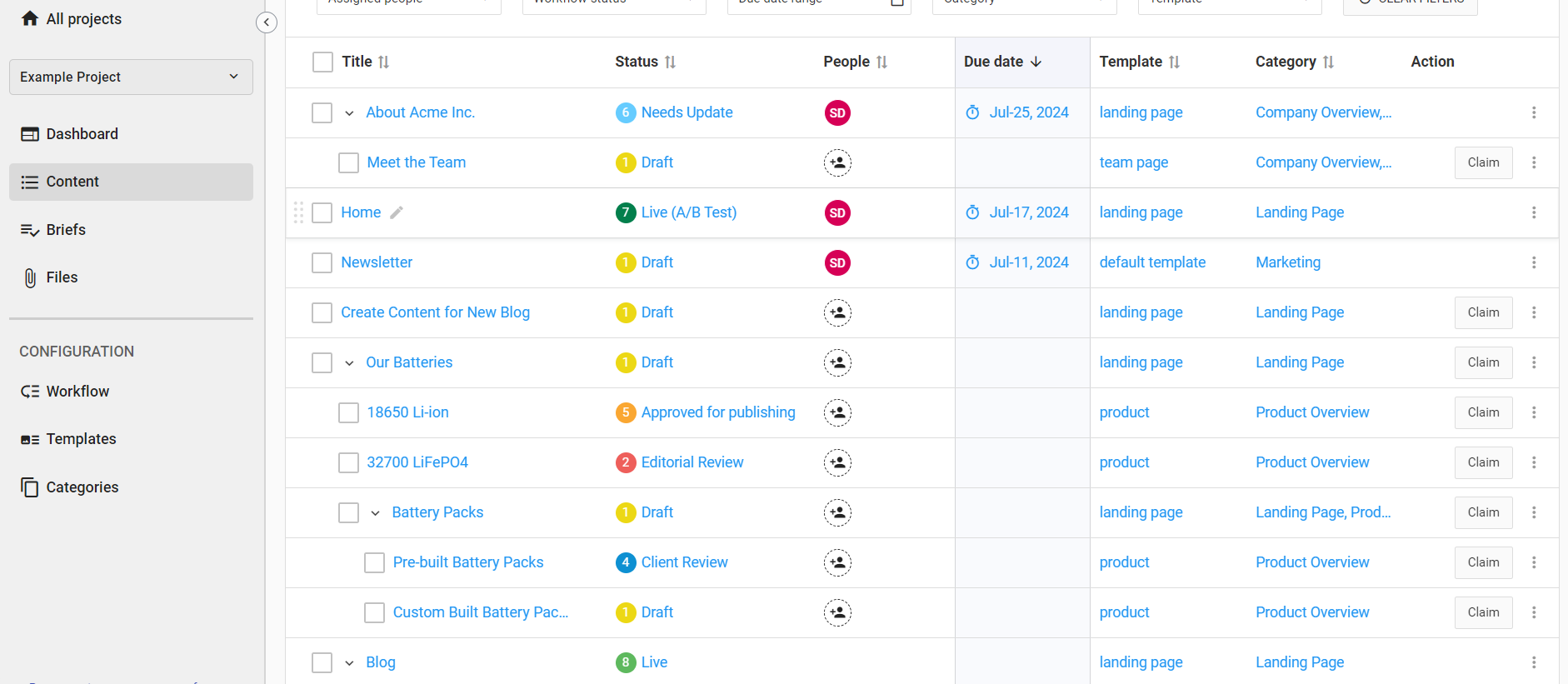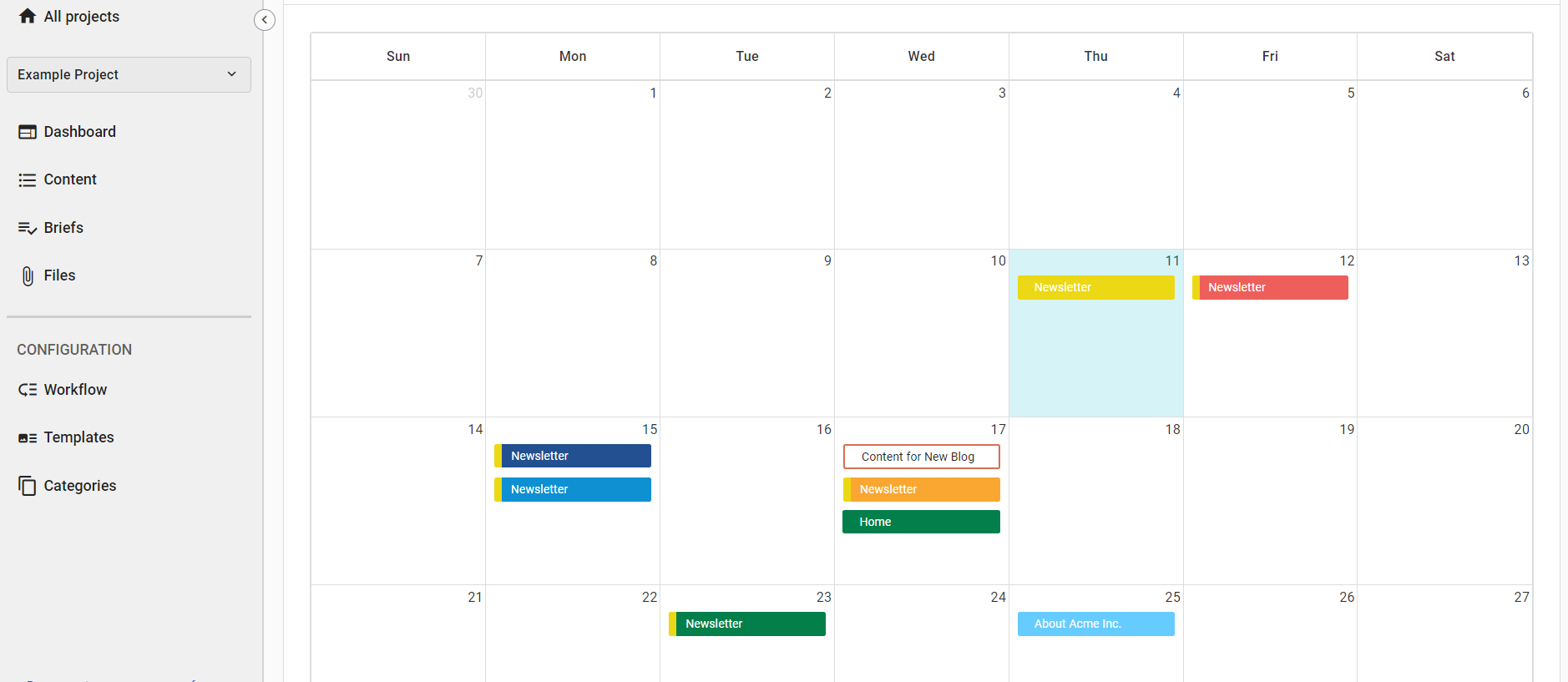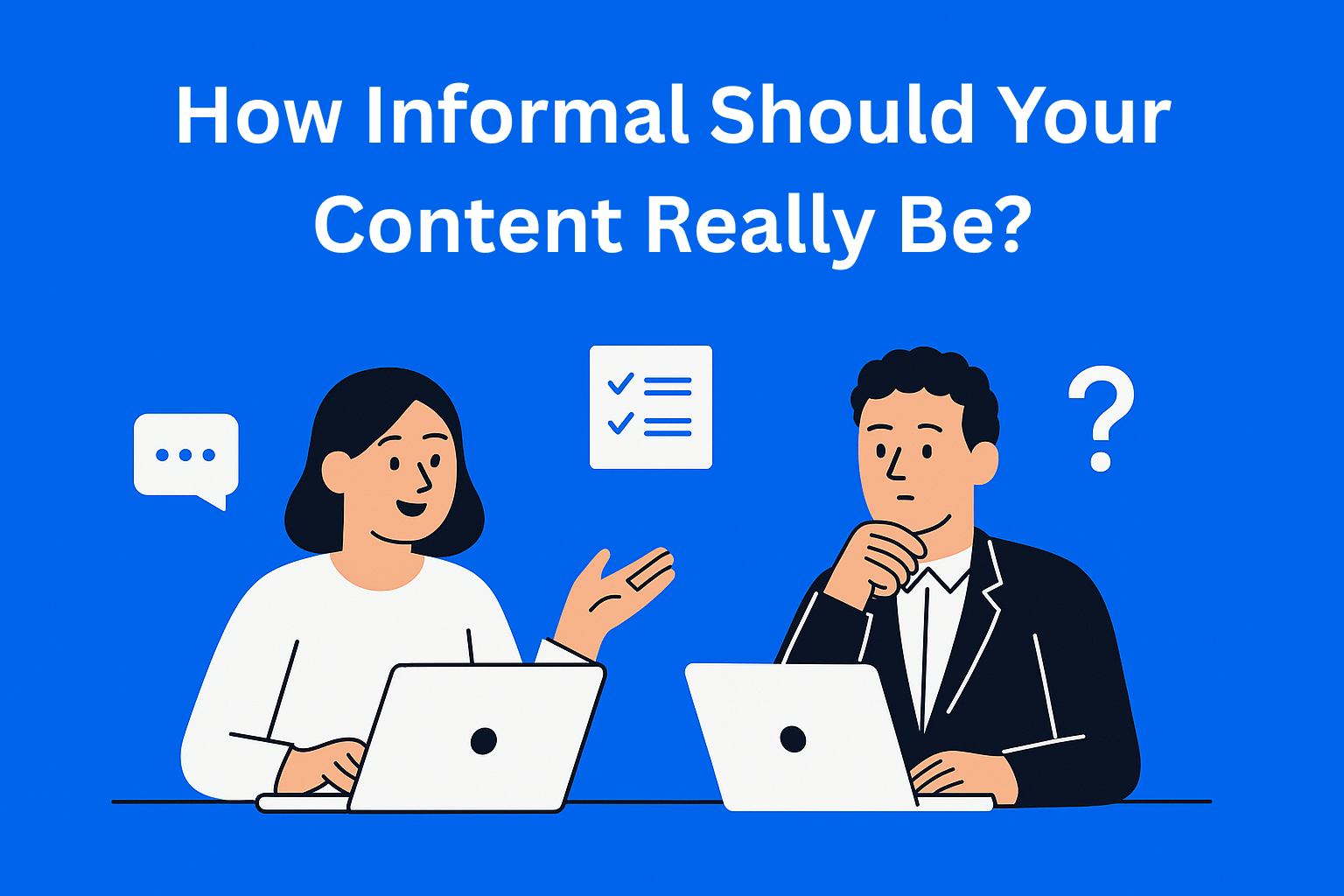Creating an Effective Content Plan: Step-by-Step Guide
Creating an effective content plan is crucial for business success. This guide covers setting SMART goals, understanding your audience, conducting content audits, brainstorming ideas, and creating a content calendar. EasyContent simplifies the process, ensuring high-quality and impactful content.

In today's fast-paced digital world, having a well-structured content plan is crucial for any business aiming to make a significant impact online. A content plan serves as a roadmap, guiding your content creation, distribution, and management efforts. It ensures consistency, aligns your content with business goals, and helps you effectively engage with your target audience.
Without a structured content plan, businesses often face numerous challenges. Content efforts can become disorganized, leading to inconsistent messaging and missed opportunities. The lack of clear objectives makes it difficult to measure success, while the absence of a cohesive strategy can result in wasted resources and diminished returns on investment. Additionally, without a plan, it's challenging to maintain a steady flow of high-quality content, which can negatively impact audience engagement and brand credibility.
This is where EasyContent comes in. EasyContent is designed to simplify and streamline the entire content planning and management process. With its intuitive features, EasyContent helps you set clear goals, organize your content ideas, and maintain a consistent publishing schedule. Whether you're conducting a content audit or analyzing performance metrics, EasyContent provides the tools you need to ensure your content strategy is both effective and efficient. By leveraging EasyContent, businesses can overcome the challenges of unstructured content efforts and achieve their content marketing objectives with ease.
Understanding the Basics of a Content Plan
Definition of a Content Plan
A content plan is a strategic outline that guides the creation, delivery, and governance of useful, usable content. It involves setting objectives, defining your target audience, deciding on the types of content to create, and determining the channels through which to distribute it. A well-crafted content plan acts as a roadmap, ensuring that all content efforts align with your business goals and audience needs.
Key Components of a Successful Content Plan
- Goals: Clear, measurable objectives that your content efforts aim to achieve. These could include increasing brand awareness, driving traffic, generating leads, or boosting customer engagement.
- Audience: A detailed understanding of who your content is intended for. This involves creating audience personas based on demographics, interests, behaviors, and pain points.
- Content Types: The various formats your content will take, such as blog posts, videos, infographics, social media updates, and podcasts. It's essential to choose formats that resonate with your audience and fit your goals.
- Content Topics: The themes and subjects your content will cover. These should address your audience's interests and challenges, providing value and insights.
- Content Calendar: A schedule outlining when and where each piece of content will be published. This helps maintain consistency and ensures timely delivery.
- Distribution Channels: The platforms and channels where your content will be shared, such as your website, social media, email newsletters, and third-party sites.
- Metrics and KPIs: Key performance indicators to measure the success of your content efforts. Common metrics include engagement rates, website traffic, lead generation, and conversion rates.
Benefits of Having a Content Plan in Place
- Consistency: A content plan ensures that you maintain a steady flow of content, which helps build and sustain audience engagement.
- Alignment with Business Goals: By setting clear objectives, a content plan aligns your content efforts with your overall business strategy, ensuring that each piece of content serves a purpose.
- Efficiency: Planning ahead allows you to allocate resources effectively, streamline the content creation process, and avoid last-minute rushes.
- Audience Engagement: A well-researched content plan helps you create content that resonates with your target audience, addressing their needs and interests.
- Performance Measurement: With defined metrics and KPIs, you can track the effectiveness of your content and make data-driven decisions to optimize your strategy.
- Resource Management: A content plan helps you manage your team and budget more efficiently, ensuring that all content efforts are coordinated and cost-effective.
Setting Clear Goals for Your Content
Importance of Setting SMART Goals
Setting clear goals is fundamental to the success of any content strategy. SMART goals—Specific, Measurable, Achievable, Relevant, and Time-bound—provide a structured framework that ensures your content efforts are aligned with your business objectives. Here’s why each component of SMART goals is essential:
- Specific: Goals should be well-defined and clear to everyone involved. A specific goal answers the questions of who, what, where, when, and why, eliminating ambiguity.
- Measurable: To track progress and determine success, goals must have measurable criteria. This allows you to quantify your efforts and see tangible results.
- Achievable: Goals need to be realistic and attainable, considering available resources and constraints. Setting achievable goals ensures that your team remains motivated and focused.
- Relevant: Your goals should align with broader business objectives and be pertinent to your current market conditions and environment. This relevance ensures that your content strategy contributes meaningfully to the overall mission.
- Time-bound: Every goal should have a deadline or a timeframe. This creates a sense of urgency and helps prioritize tasks, ensuring timely execution and review.
Examples of Common Content Goals
Here are some typical content goals that businesses often set to drive their content strategy:
- Brand Awareness: Increasing brand visibility and recognition through high-quality content that resonates with your target audience.
- Lead Generation: Attracting potential customers by providing valuable content that encourages them to share their contact information.
- Customer Engagement: Building a loyal audience by creating engaging content that fosters interaction and strengthens the relationship with your customers.
- Website Traffic: Driving more visitors to your website through optimized and targeted content.
- SEO Performance: Improving search engine rankings by producing content that is optimized for relevant keywords.
- Sales: Boosting conversions and sales through content that effectively highlights the benefits and features of your products or services.
- Thought Leadership: Establishing your brand as an industry leader by creating insightful and authoritative content.
How EasyContent Helps Align Your Content Goals with Overall Business Objectives
EasyContent is designed to seamlessly integrate your content goals with your business objectives. Here’s how it supports each aspect of SMART goals:
- Goal Setting: EasyContent allows you to set specific, clear goals within its platform, ensuring everyone on your team is aligned and aware of the targets.
- Tracking and Measurement: With robust analytics and reporting features, EasyContent makes it easy to measure progress towards your goals. You can track key performance indicators (KPIs) and analyze the effectiveness of your content in real-time.
- Achievability: EasyContent’s project management tools help you plan and allocate resources efficiently, ensuring that your goals are realistic and attainable.
- Relevance: By providing insights into market trends and audience preferences, EasyContent ensures your goals remain relevant and aligned with broader business strategies.
- Time Management: EasyContent’s scheduling and calendar features help you set deadlines and keep your team on track, ensuring timely delivery of content.
By leveraging EasyContent, businesses can set SMART goals that are not only well-defined and measurable but also achievable, relevant, and time-bound. This alignment ensures that your content strategy effectively supports and drives your overall business objectives.
Identifying and Understanding Your Target Audience
Techniques for Identifying Your Target Audience
Understanding who your audience is and what they need is crucial for creating relevant and engaging content. Here are some effective techniques for identifying your target audience:
- Surveys: Conducting surveys allows you to gather direct feedback from your current audience. You can ask questions about their preferences, challenges, and interests. Online survey tools like SurveyMonkey or Google Forms can facilitate this process.
- Market Research: This involves analyzing industry reports, studying competitors, and examining market trends to understand the broader landscape. Market research helps you identify potential audience segments and uncover unmet needs.
- Analytics: Utilizing web and social media analytics tools like Google Analytics, Facebook Insights, and Twitter Analytics can provide valuable data about your audience's demographics, behaviors, and engagement patterns. These insights help you understand who is interacting with your content and how.
Creating Audience Personas
Once you’ve gathered data about your audience, the next step is to create audience personas. Audience personas are fictional, generalized representations of your ideal customers. They help you understand and empathize with your audience, ensuring your content addresses their specific needs and preferences. Here’s how to create effective audience personas:
- Collect Data: Use the information gathered from surveys, market research, and analytics to identify common characteristics and behaviors among your audience.
- Define Characteristics: Outline the key traits of each persona, including demographics (age, gender, location), psychographics (interests, values, lifestyle), and behavioral patterns (content consumption habits, purchase behavior).
- Create Profiles: Develop detailed profiles for each persona, giving them names and backstories to make them more relatable. Include information about their goals, challenges, and how your content can help them achieve their objectives.
- Visualize Personas: Use visuals, such as images or infographics, to make your personas more tangible. This can help your team better understand and remember the different audience segments.
By identifying and understanding your target audience through surveys, market research, and analytics, and by creating detailed audience personas, you can craft content that truly resonates with your audience.
Conducting a Content Audit
Purpose and Process of a Content Audit
A content audit is a comprehensive review of all the content assets your business has created. The primary purpose of a content audit is to evaluate the performance and relevance of your content, ensuring it aligns with your current business goals and audience needs. Here’s a step-by-step process to conduct an effective content audit:
- Define Your Goals: Clearly outline what you want to achieve with the content audit. This could include improving SEO performance, identifying high-performing content, or aligning content with new business objectives.
- Inventory Your Content: Compile a list of all your content assets. This includes blog posts, articles, videos, infographics, social media posts, eBooks, and any other content formats. Use tools like spreadsheets or content audit software to keep track of each piece.
- Gather Data: Collect data on each content piece. Key metrics to track include page views, engagement rates, social shares, conversion rates, and SEO performance. Use analytics tools like Google Analytics, social media insights, and SEO software to gather this information.
- Evaluate Content Quality: Assess the quality of your content based on factors such as relevance, accuracy, readability, and engagement. Determine if the content still aligns with your brand voice and business goals.
- Categorize Your Content: Organize your content into categories based on themes, formats, and performance. This will help you identify patterns and trends.
- Identify Gaps and Opportunities: Analyze the data to find gaps in your content. Look for topics that are underrepresented or overrepresented. Identify high-performing content that can be repurposed or updated to maximize its impact.
Identifying Gaps and Opportunities in Your Existing Content
During your content audit, you may uncover several gaps and opportunities, such as:
- Content Gaps: These are areas where your audience's needs are not being fully met. For example, you might find that you have plenty of content targeting beginners but lack advanced resources.
- Performance Gaps: Identify content that is underperforming based on metrics like low engagement or poor SEO ranking. These pieces may need to be updated, optimized, or removed.
- Top-Performing Content: Highlight content that consistently performs well. This content can be used as a model for future content or repurposed into different formats to reach a broader audience.
- Content Redundancies: Find and eliminate duplicate content that may confuse your audience or negatively impact your SEO.
- New Opportunities: Discover trending topics or emerging audience needs that you can address with new content. This proactive approach helps keep your content strategy fresh and relevant.
Utilizing EasyContent to Organize and Analyze Your Current Content Inventory

EasyContent provides robust tools to simplify and streamline your content audit process. Here’s how EasyContent can help:
- Content Inventory Management: EasyContent allows you to catalog all your content assets in one place. You can easily tag, categorize, and organize your content for better visibility and management.
- Quality Assessment: EasyContent’s built-in quality assessment tools help you evaluate the relevance, accuracy, and engagement levels of your content. You can set custom criteria to ensure your content meets your brand’s standards.
- Gap Analysis: EasyContent enables you to perform detailed gap analysis by highlighting underperforming content and identifying areas that require new or improved content. This feature helps you address audience needs more effectively.
- Collaborative Workflows: EasyContent’s collaborative features allow your team to work together efficiently during the content audit process. You can assign tasks, share feedback, and track progress in real-time.
By conducting a thorough content audit, you can ensure that your content strategy remains effective and aligned with your business goals. EasyContent’s comprehensive tools make it easier to organize, analyze, and optimize your content inventory, helping you uncover valuable opportunities and maintain a high standard of content quality.
Brainstorming and Planning Content Ideas
Methods for Generating Content Ideas
Generating fresh and engaging content ideas is crucial for maintaining a dynamic content strategy. Here are some effective methods for brainstorming and planning content ideas:
- Brainstorming Sessions: Gather your team for structured brainstorming sessions. Encourage open discussion and the sharing of diverse perspectives. Use techniques like mind mapping, where a central idea branches out into related topics, to generate a wide range of ideas.
- Keyword Research: Utilize keyword research tools like Google Keyword Planner, Ahrefs, or SEMrush to identify popular search terms related to your industry. This helps you understand what topics your audience is interested in and what they are searching for.
- Competitor Analysis: Analyze the content strategies of your competitors. Identify the topics they cover, the formats they use, and the engagement they receive. This can provide inspiration and highlight gaps in your own content strategy.
- Audience Feedback: Engage with your audience directly through surveys, social media, or comments on your blog. Ask them what topics they are interested in and what questions they need answered.
- Industry Trends: Stay updated with the latest trends in your industry by following news sources, blogs, and thought leaders. Trending topics can provide timely and relevant content ideas.
- Content Performance Analysis: Review the performance of your existing content. Identify high-performing pieces and think about how you can expand on those topics or repurpose the content into different formats.
Categorizing Content Ideas by Format, Theme, and Channel
Once you have a list of potential content ideas, it's important to categorize them to ensure a balanced and organized content strategy. Here’s how to do it:
- By Format:
- Blog Posts: In-depth articles that provide valuable information and insights.
- Videos: Engaging visual content that can include tutorials, interviews, or storytelling.
- Infographics: Visual representations of data and information that are easy to understand and share.
- Podcasts: Audio content that can include discussions, interviews, or narrations.
- Social Media Posts: Short, engaging content designed for platforms like Facebook, Twitter, Instagram, and LinkedIn.
- eBooks and Whitepapers: Comprehensive guides or reports that provide detailed information on specific topics.
- Webinars and Live Streams: Interactive sessions that allow for real-time engagement with your audience.
- By Theme:
- Educational: Content that teaches your audience something new or provides how-to guides.
- Inspirational: Content that motivates and inspires your audience.
- Informative: Content that provides news, updates, or in-depth information on specific topics.
- Entertaining: Content designed to entertain, such as humorous posts, stories, or engaging videos.
- Promotional: Content that highlights your products, services, or brand achievements.
- By Channel:
- Website: Content primarily hosted on your website, such as blog posts, articles, and landing pages.
- Social Media: Content tailored for specific social media platforms.
- Email: Content designed for email newsletters and campaigns.
- Third-Party Sites: Guest posts, collaborations, and content shared on other websites or platforms.
By categorizing your content ideas, you can ensure a well-rounded content strategy that covers various formats, themes, and channels. This approach helps in maintaining a diverse content mix that appeals to different segments of your audience and keeps your content fresh and engaging.
Creating a Content Calendar
Importance of a Content Calendar in Maintaining Consistency
A content calendar is an essential tool for planning, organizing, and scheduling your content. It ensures that your content efforts are consistent and timely, which is crucial for maintaining audience engagement and building a loyal following. Here’s why a content calendar is important:
- Consistency: A content calendar helps you maintain a regular publishing schedule, which is key to keeping your audience engaged and coming back for more.
- Organization: It allows you to plan ahead, ensuring that you have a balanced mix of content types and themes. This prevents last-minute rushes and helps you manage your resources more effectively.
- Alignment: A content calendar ensures that your content aligns with your marketing campaigns, product launches, and other important business activities.
- Accountability: It provides a clear roadmap for your team, outlining who is responsible for creating, reviewing, and publishing each piece of content.
- Analysis and Improvement: With a content calendar, you can track the performance of your content over time and make data-driven decisions to optimize your strategy.
Steps to Create an Effective Content Calendar
- Set Clear Goals: Start by defining the objectives of your content strategy. What do you want to achieve with your content? Your goals will guide your content planning and scheduling.
- Identify Key Dates and Events: Mark important dates, such as holidays, industry events, product launches, and marketing campaigns. This ensures that your content is timely and relevant.
- Determine Content Types and Themes: Decide on the types of content you want to create (e.g., blog posts, videos, social media updates) and the themes you want to cover. This helps maintain variety and keeps your content strategy aligned with your goals.
- Plan Content Frequency: Determine how often you will publish content. This could be daily, weekly, or monthly, depending on your resources and audience preferences. Consistency is more important than quantity.
- Assign Responsibilities: Clearly outline who is responsible for each task, from content creation to publishing. This ensures accountability and helps manage workloads.
- Schedule Content: Use your calendar to schedule each piece of content. Include deadlines for drafts, reviews, and publishing dates. Make sure to allocate time for promotion and distribution as well.
- Review and Adjust: Regularly review your content calendar to ensure it’s working effectively. Be flexible and make adjustments as needed based on performance data and feedback.
How EasyContent Can Simplify Calendar Creation and Scheduling

EasyContent offers a comprehensive set of tools to simplify the creation and management of your content calendar:
- Centralized Planning: EasyContent allows you to plan all your content in one centralized platform. You can easily view your entire content schedule and make adjustments as needed.
- Drag-and-Drop Interface: The intuitive drag-and-drop interface makes it easy to schedule and reschedule content. You can quickly move content around to accommodate changes or new priorities.
- Automated Workflows: EasyContent’s automated workflows streamline the content creation process. You can set up automated reminders and notifications to ensure that deadlines are met and tasks are completed on time.
- Collaboration Tools: EasyContent facilitates collaboration by allowing team members to comment, review, and approve content directly within the platform. This ensures smooth communication and reduces the risk of errors.
- Customizable Templates: EasyContent provides customizable calendar templates that can be tailored to your specific needs. This saves time and ensures that your calendar is structured in a way that works best for your team.
By using EasyContent, you can create an effective content calendar that keeps your content strategy organized, consistent, and aligned with your business goals. This not only simplifies the planning and scheduling process but also enhances the overall efficiency and effectiveness of your content efforts.
Producing High-Quality Content
Tips for Producing Engaging and Valuable Content
Creating high-quality content is essential for capturing and retaining your audience's attention. Here are some tips for producing content that is both engaging and valuable:
- Know Your Audience: Understand your target audience's needs, preferences, and pain points. Tailor your content to address these aspects and provide solutions.
- Craft Compelling Headlines: Your headline is the first thing readers see. Make it attention-grabbing, clear, and relevant to encourage clicks and engagement.
- Provide Value: Focus on delivering content that offers real value to your audience. This can include educational information, actionable tips, insights, or entertainment.
- Use Visuals: Incorporate images, infographics, videos, and other visual elements to make your content more appealing and easier to digest.
- Tell Stories: People connect with stories. Use storytelling techniques to make your content more relatable and memorable.
- Keep it Clear and Concise: Avoid jargon and keep your language simple. Get to the point quickly and make your content easy to read.
- Include Calls to Action (CTAs): Guide your audience on what to do next, whether it’s subscribing to your newsletter, downloading a resource, or contacting you for more information.
- Edit and Proofread: Ensure your content is free of errors and flows smoothly. Editing and proofreading are crucial steps in maintaining professionalism and credibility.
Importance of SEO and Keyword Optimization
SEO (Search Engine Optimization) is vital for ensuring your content reaches a broader audience by ranking higher in search engine results. Here’s why SEO and keyword optimization are important:
- Increased Visibility: Optimized content is more likely to appear in search engine results, driving organic traffic to your site.
- Better User Experience: SEO practices often enhance the user experience by making content more accessible, faster to load, and easier to navigate.
- Targeted Traffic: Keyword optimization helps attract visitors who are specifically searching for the topics you cover, increasing the likelihood of engagement and conversions.
- Competitive Advantage: Effective SEO can help you outrank competitors and establish your brand as an authority in your industry.
Distributing and Promoting Your Content
Strategies for Effective Content Distribution
Distributing your content effectively ensures that it reaches the right audience and achieves its intended impact. Here are some key strategies for successful content distribution:
- Social Media: Utilize various social media platforms (Facebook, Twitter, LinkedIn, Instagram, etc.) to share your content. Tailor your posts to fit the platform’s format and audience preferences. Engage with your followers by responding to comments and encouraging shares.
- Email Marketing: Leverage your email list to distribute content directly to your subscribers. Create engaging newsletters that highlight your latest content, offer exclusive insights, and provide valuable resources. Personalized email campaigns can also boost engagement.
- Partnerships and Collaborations: Partner with influencers, industry experts, and complementary businesses to expand your reach. Guest posting, co-creating content, and cross-promotions can introduce your content to new audiences and build credibility.
- Content Syndication: Share your content on third-party websites, forums, and content syndication networks to reach a broader audience. This can help drive traffic back to your site and improve your content’s visibility.
- Paid Promotion: Use paid advertising options such as Google Ads, social media ads, and sponsored content to boost your content’s reach. Targeted ads can help you reach specific audience segments more effectively.
- SEO and Organic Search: Optimize your content for search engines to increase organic traffic. Use relevant keywords, meta tags, and high-quality backlinks to improve your search engine rankings.
Importance of Repurposing Content Across Different Channels
Repurposing content involves adapting your existing content for different formats and platforms. This strategy maximizes the value of your content and extends its reach. Here’s why repurposing is important:
- Increased Reach: Repurposing allows you to reach different audience segments that prefer various content formats. For example, a blog post can be turned into an infographic, a video, or a podcast episode.
- Content Longevity: By repurposing, you can keep your content fresh and relevant over time. Updating and re-sharing older content can help maintain its visibility and impact.
- Efficiency: Creating new content from scratch can be time-consuming and resource-intensive. Repurposing existing content saves time and effort while still delivering valuable information to your audience.
- SEO Benefits: Repurposing content can improve your SEO by creating multiple pieces of content around the same topic, which can enhance your authority and relevance in search engines.
Measuring and Analyzing Performance
Key Metrics to Track the Success of Your Content
To ensure your content strategy is effective, it's crucial to track various metrics that indicate the performance and impact of your content. Here are some key metrics to monitor:
- Traffic:
- Page Views: The total number of times a page on your site is viewed. High page views indicate that your content is attracting visitors.
- Unique Visitors: The number of distinct individuals visiting your site. This helps you understand your reach and audience size.
- Traffic Sources: Identify where your traffic is coming from (e.g., organic search, social media, referral, direct). This helps you understand which channels are most effective.
- Engagement:
- Bounce Rate: The percentage of visitors who leave your site after viewing only one page. A high bounce rate may indicate that your content isn’t engaging or relevant.
- Average Time on Page: The average amount of time visitors spend on a page. Longer time on page suggests that your content is engaging and holding visitors' attention.
- Pages Per Session: The average number of pages viewed during a single session. More pages per session indicate that visitors are exploring more of your content.
- Social Shares: The number of times your content is shared on social media platforms. High shares suggest that your content is valuable and resonating with your audience.
- Comments and Interactions: The number of comments, likes, and other interactions your content receives. This shows how actively engaged your audience is with your content.
- Conversions:
- Conversion Rate: The percentage of visitors who take a desired action, such as signing up for a newsletter, downloading a resource, or making a purchase. This metric directly ties your content to business goals.
- Lead Generation: The number of leads generated through your content. This can include form submissions, contact inquiries, and other lead capture methods.
- Customer Retention: The ability of your content to retain existing customers, indicated by repeat visits, ongoing engagement, and continued purchases.
Tools and Techniques for Performance Analysis
Several tools and techniques can help you measure and analyze the performance of your content. Here are some of the most effective ones:
- Google Analytics: This free tool provides comprehensive insights into your website’s traffic, user behavior, and conversion metrics. It helps you understand how visitors interact with your content and identify areas for improvement.
- Social Media Analytics: Platforms like Facebook, Twitter, Instagram, and LinkedIn offer built-in analytics tools to track engagement, reach, and interactions. These insights help you optimize your social media content.
- SEO Tools: Tools like Ahrefs, SEMrush, and Moz provide data on keyword rankings, backlinks, and organic search traffic. They help you track the SEO performance of your content and identify opportunities for optimization.
- Email Marketing Analytics: Email platforms like Mailchimp, Constant Contact, and HubSpot offer analytics to track open rates, click-through rates, and conversions. This helps you understand how your email content is performing.
- Heatmaps and User Behavior Tools: Tools like Hotjar and Crazy Egg provide visual representations of user interactions on your site. Heatmaps show where users click, scroll, and spend the most time, helping you optimize content layout and design.
- Content Management Systems (CMS) Analytics: Many CMS platforms, such as WordPress and HubSpot, offer built-in analytics to track content performance directly within the platform.
Techniques for Performance Analysis:
- Regular Reporting: Create regular reports (weekly, monthly, quarterly) to monitor and analyze your content performance. This helps you identify trends and measure progress over time.
- A/B Testing: Experiment with different content formats, headlines, images, and calls to action to see which versions perform better. A/B testing helps you optimize your content for maximum impact.
- User Feedback: Collect feedback from your audience through surveys, comments, and direct interactions. This qualitative data provides insights into how your content is perceived and what improvements can be made.
- Competitor Analysis: Regularly analyze the content performance of your competitors. Identify what’s working for them and incorporate similar strategies into your own content plan.
By tracking key metrics and using the right tools and techniques for performance analysis, you can gain valuable insights into the effectiveness of your content strategy. This allows you to make data-driven decisions, optimize your content, and achieve your business goals more efficiently.
Continuous Improvement and Optimization
Importance of Regularly Reviewing and Updating Your Content Plan
A content plan should not be a static document. The digital landscape, audience preferences, and business goals are constantly evolving, making it essential to regularly review and update your content plan. Here’s why continuous improvement and optimization are crucial:
- Adapt to Changes: Regular reviews help you stay ahead of industry trends, changes in audience behavior, and updates in search engine algorithms. This adaptability ensures your content remains relevant and effective.
- Identify Opportunities: By consistently evaluating your content plan, you can identify new opportunities for content creation, repurposing, or distribution. This keeps your strategy dynamic and innovative.
- Improve Performance: Continuous assessment allows you to identify what’s working and what’s not. By making data-driven adjustments, you can improve the overall performance of your content strategy.
- Resource Allocation: Regular updates help in better resource allocation. You can reassign resources from underperforming areas to those that yield higher returns.
- Maintain Consistency: Ongoing optimization ensures that your content maintains a consistent quality and aligns with your brand voice and messaging.
Gathering Feedback and Making Data-Driven Improvements
To optimize your content strategy effectively, it’s essential to gather feedback and make improvements based on data. Here’s how you can achieve this:
- Audience Feedback: Direct feedback from your audience is invaluable. Use surveys, polls, and feedback forms to understand their needs, preferences, and pain points. Social media interactions and comments on your blog or videos also provide insights into audience sentiment.
- Content Performance Data: Leverage analytics tools to track the performance of your content. Monitor key metrics such as traffic, engagement, conversions, and bounce rates. Tools like Google Analytics, social media analytics, and SEO tools provide comprehensive data on how your content is performing.
- User Behavior Analysis: Tools like heatmaps, session recordings, and user journey tracking (e.g., Hotjar, Crazy Egg) help you understand how users interact with your content. This data reveals areas where users are most engaged and where they drop off.
- A/B Testing: Conduct A/B tests on various content elements such as headlines, CTAs, images, and formats. Testing different variations helps you determine what resonates best with your audience and drives the desired actions.
- Competitor Analysis: Regularly analyze your competitors’ content strategies. Identify what types of content perform well for them and consider how you can incorporate similar tactics into your strategy.
- Internal Team Feedback: Gather insights from your team members who are involved in content creation and distribution. They can provide valuable perspectives on what’s working well and what challenges they face.
Making Data-Driven Improvements:
- Analyze Performance Data: Regularly review the performance data of your content. Identify high-performing pieces and analyze the factors contributing to their success. Conversely, pinpoint underperforming content and understand the reasons behind it.
- Update Content: Refresh outdated content with new information, updated statistics, and current examples. This not only improves its relevance but also enhances its SEO value.
- Repurpose Content: Convert high-performing content into different formats. For example, turn a successful blog post into a video, infographic, or podcast episode to reach a wider audience.
- Optimize SEO: Continuously update your SEO strategy based on performance data. Refine keywords, meta tags, and backlinks to improve your search engine rankings.
- Improve User Experience: Use insights from user behavior analysis to enhance the usability and readability of your content. Simplify navigation, improve load times, and ensure mobile-friendliness.
- Implement Feedback: Integrate audience and team feedback into your content planning process. Address common suggestions and make improvements that align with your audience’s needs.
By regularly reviewing and updating your content plan, gathering feedback, and making data-driven improvements, you can ensure that your content strategy remains effective, relevant, and aligned with your business goals. Continuous optimization not only enhances the quality and impact of your content but also helps you stay competitive in an ever-changing digital landscape.
Conclusion
Creating an effective content plan involves a series of strategic steps that ensure your content efforts are organized, targeted, and impactful. Here’s a recap of the essential steps:
- Understanding the Basics of a Content Plan: Define your content plan, understand its key components, and recognize its benefits.
- Setting Clear Goals for Your Content: Establish SMART goals that are specific, measurable, achievable, relevant, and time-bound.
- Identifying and Understanding Your Target Audience: Use techniques like surveys, market research, and analytics to identify your audience and create detailed personas.
- Conducting a Content Audit: Review and analyze your existing content to identify gaps and opportunities.
- Brainstorming and Planning Content Ideas: Generate and categorize content ideas by format, theme, and channel.
- Creating a Content Calendar: Plan and schedule your content to maintain consistency and align with your marketing efforts.
- Producing High-Quality Content: Focus on creating engaging, valuable, and SEO-optimized content.
- Distributing and Promoting Your Content: Utilize effective strategies for content distribution and repurpose content across different channels.
- Measuring and Analyzing Performance: Track key metrics and use tools to analyze content performance.
- Continuous Improvement and Optimization: Regularly review and update your content plan based on feedback and data-driven insights.
Benefits of Using EasyContent for a Streamlined Content Planning Process
EasyContent is designed to simplify and enhance every aspect of your content planning process. By leveraging EasyContent, you can:
- Centralize Planning: Manage all your content planning in one place with an intuitive, user-friendly interface.
- Automate Workflows: Streamline the content creation and approval processes with automated workflows and reminders.
- Collaborate Efficiently: Improve team collaboration with integrated tools for commenting, reviewing, and approval.
- Optimize SEO: Utilize built-in SEO tools to ensure your content is optimized for search engines from the start.
- Track Performance: Access detailed reports and performance metrics to make data-driven decisions and continuously improve your content strategy.
- Customize Templates: Use customizable content templates and editorial calendar formats to suit your specific needs.
Ready to take your content planning to the next level? Try EasyContent today and experience the benefits of a streamlined, efficient, and effective content management process. Sign up now and start creating high-quality, impactful content that drives your business forward.






